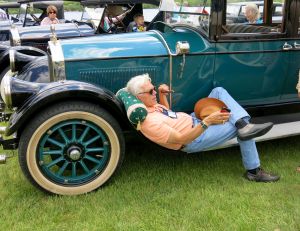- Home
- About Us
- Join/Renew
- Member Benefits
- Member Pages
- Log In
- Help
- Museum Store
Bob,
BTW, Bernie’s listing of P-A ownership lists a 1915, 38-C-3, Limousine owned by a S. H. Knox, of 1045 Delaware Avenue, Buffalo.
S. H. Knox is Seymour H. Knox.
He is listed as the sole owner, so I wonder if it remains in the family.
The plot thickens!
Peter
Bob,
If it was made for the Marine Midland Bank, then it was probably made for either Seymour Knox II or Northrup Knox, Sr., as they were, sequentially, Chairman of the Board of Marine Midland, as was Seymour Knox I, before they assumed the position.
Peter
Ken,
The method of entry is to step on the running board, put your right leg / foot in and through to the right side of the steering wheel.
Then proceed to move your butt to the seat while sliding your left leg / foot through the small gag between the door jam and the seat.
Shoe type and size matters, so no big clunky athletic shoes.
Slim, form fitting shoes, as in, driving shoes, are best!
Getting out requires that I lift my left leg up and over the top of the seat and outward. I near hit the door with my foot while doing this maneuver.
I then drag my right leg / foot through the same gap (door jam and seat) that I used as the entry point for my left foot / leg.
Measurements will follow.
Peter
David,
Funny Boy!
One only wonders what Charles Tittering would have designed if he and his wife had a girl child!
Peter
Good evening Series 80 Gents,
Well, what an interesting experiment!
I went to my Series 80 today with four 1X2X6-inch pieces of pine.
First I sat in the front seat to reference how easily I could lift my left and right foot to reach the pedals.
Then I inserted one (1) 1X2X6 between the seat cushion frame and the base, one on the driver’s side and one on the passenger side (balance).
There was an interesting difference; a seemingly improved ability to lift my legs to move them on to the brake and clutch pedals.
I then repeated the process using two (2) 1X2X6 pieces stacked one on the other.
This also provided an interesting and seemingly improved ability to lift my foot off of the gas pedal and move it to the brake, likewise to lift my foot from the floor and reach the clutch pedal.
Note that the distance between my knee and the steering wheel diminished slightly with each lift, but that was not a problem as my knees sit on the outer edge of the wheel.
This whole process caused the seat bottom to not “seat” properly to the rear, but I whacked it a few times and it moved rearward, even if it did not lock into place because of the increased gap between the seat platform frame and the seat frame.
I think it is worth further investigating.
Soon, I will buy two (2) 1X2X48-inch pieces of wood and see how it works when driving.
Of course, I will attach the wood to the platform frame and add a restraining piece on the front of the frame so that the seat bottom does not shift while driving.
WOW, what an interesting concept, but enacting it will require creating a angled piece of wood to fit along the driver side and passenger outboard edge of the frame to fill the large angled gap that this intervention produces.
Again, interesting.
If it proves effective we all need to buy Stewart Blair a Scotch or two.
Peter
Gents,
Tomorrow, I am going to put a 1-inch thick board under the front edge of the base of the seat bottom of my Series 80 to test out Stuart’s concept.
I will report on the experiment.
It would be a wonderfully simple solution.
Also, David White,
When you write that you got your guy to FIRM UP the lower cushion, was there a difference in the height of the seat cushion (shorter) when it returned from the shop?
Did he replace the springs with shorter, firmer springs, or bind your springs into a shorter stance?
Peter
Bob,
Packard Green???
UCK!
How about something like a Pierce Green?
Peter
Tom,
BTW, the color is beautiful and it looks GREEN to me.
Peter
Randy,
The problem for Tall Gents is not the steering wheel placement, per se, but the distance to the pedals.
If one is over 6-feet tall, one needs to pull one’s knees up to one’s chin to place one’s size 12s on the brake and clutch pedal.
While touring, I often use the throttle adjustment on the steering wheel as my accelerator.
For many of we Series 80 Gents, moving the seat assembly is not possible, but thinning the depth of the seat backrest is a viable option.
Shortening one’s legs is out of the question unless one goes Full Bionic.
Peter
Randy,
I believe that the front seat backrest on a Series 80 Sedan is also bolted to the “B” column, so moving it rearward is not just a matter of unbolting the seat bottom frame from the floor and sliding the entire unit back.
If it were that simple, people would have written about that ability months ago when this message thread began.
In my Series 80 7-Passenger DeLuxe, the back of the front seat almost touches the stowed jump seats.
Ken does not have that limitation, but his 5-Passenger has a shorter body than that on the 7-Passenger car.
Peter
A VERY COOL RIDE!
Ken,
You should consider getting in touch with PAS Members, Wayne or Marc Hancock, who are Series 80 Gents and who beautifully restored their Series 80 Runabout that won the Weis Award a few years back.
That backrest arrangement is attached differently than is the arrangement in the Sedan, but they can tell you firsthand about having shorter springs installed in the backrest and retaining sufficient comfort and an original look.
I understand your hesitance at digging in to your front seat backrest, but it sounds necessary.
I will do mine when the reproduction – original style upholstery material arrives from SMS, but yours seems to be a stock material that the auto upholstery guys could save while replacing the springs and reducing the thickness of the padding.
I bet that you could easily get another three to four inches of room and still have a comfortable Series 80 that you could actually drive. Maybe even in comfort.
Tall guys have problems that shorter people never consider (bumping heads, standing out in crowds, entering, exiting and driving Series 80 motorcars, etc.). HA!
Peter
I just inspected my 1925 Series 80 and there are no frame welds.
This is a Franken-Pierce.
As Ed Minnie stated, Caveat Emptor!
Gents,
I am going to look at my Series 80 frame and see if there is a weld on the frame in the engine compartment.
All of the Series 80 cars, regardless of Sub-Model, i.e., Runabout, Coupe, 5-Pass Touring / Sedan, 7-Pass Touring / Sedan or EDL, sat on a 130″ wheelbase frame.
Also note that this vehicle has a ton of other things that are incorrect, so venture with care.
This could be one cobbled together Franken-Pierce.
Peter
Jim,
Very Interesting!
Does your Middle Can have an Opening / Slot / Clear Lens on the Bottom to illuminate the license plate, or is that opening on the Top to illuminate your Reflector?
Perhaps, both?
If on top only then someone rotated the can 180-degrees sometime in the past.
If both, then that someone altered the can to accommodate the reflector.
I am sure that we all would like to see photos of this arrangement from different angles.
Peter
Craig & Ken,
Good eyes and a good question.
The reason it looks so strange is that according to Bernie Weis’ charts, this was a 2-door Coach that was cut in to a Runabout.
If you look, the windshield is very tall and the top looks strange.
The reason is that it is NOT a Runabout.
Peter
John,
Catch this one!
Peter

Ken,
I will look around and see if I have a spare “S” lens.
The Reverse Lens is worth $1,000,000.00, but the “S” is more common.
I ill check on it this weekend.
Peter
Ken & David,
Paul is correct, see my post on David’s other info request.
Peter
David,
I believe that the STOP light is on the inside most position and the RUNNING light is in the middle.
The REVERSE light (clear) is on the outside.
I attach a photo for review and note that this photo shows a Right-Side assembly, but the lens position is the same location, Inside to Outside.
If the lenses are in the wrong position, then you need to switch them.
Then you just need to remove the plug that goes into the back of the assembly and remove and reinstall the wires in the correct position.
The REVERSE light is ALWAYS HOT, so if you leave the car in reverse with the battery connected, you will soon have a dead battery.
You should get a 6V lantern battery at a hardware store along with two alligator clamp cords to check that everything is in the correct position.
This will keep you from shorting out the starting battery.
The 6V lamp battery will last you for many years and it is a great thing to have to check your electrical connections.
Just remember that your car is a POSITIVE GROUND.
The entire process of removing, moving and replacing those lenses and connections should take about 1-hour MAX.
Finally, remember that your car is 88-years-old and although you may think it is original, it had 88-years for someone to alter things.
On my 1925 Series 80, someone had switched the connections on the dash light switch and it took me a lot of thinking and a few hours to finally get them to switch on in the correct sequence.
When in doubt, study the Pierce-Arrow Wiring Diagram book that is available through this website, probably under Publications.
Peter

